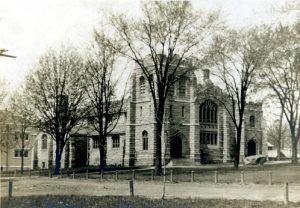“We need a chapel in which to center the religious life of this University.” – President Louis E. Holden
Construction began on Memorial Chapel soon after President Holden’s inauguration. Built to accommodate the entire university and members of the community, Memorial Chapel was the replacement for Kauke Chapel, the chapel housed within Old Main.
The construction of the library and chapel buildings was a tacit admission that Old Main could not contain the entire institution. The University had outgrown its single building. As Rowell Levy observed in his Independent Study on McGaw Chapel, religion and academics, previously unified under the same roof, had been separated.1 Through the chapel’s placement by the administration at the right hand of Old Main and later Kauke Hall, it took on symbolic prominence and prestige over the library. The University of Wooster now had a building dedicated to religion, and a building dedicated to academia.2 Old Main’s replacement, Kauke Hall which was situated between and behind the two buildings, stood as a bridge between the secular and sacred. Kauke Hall became the union between two ideals, as the balance between Christian theology and academic education.
 This ideal and the architecture that materialized it go hand in hand with Holden’s view of the great ‘Christian businessman of the future’, he had outlined in his inaugural speech. For behind the building and financing of both Memorial Chapel and the University library, were captains of industry – the great robber barons of the turn of the century. Senator Mark A. Hanna donated and dedicated the bronze memorial bell of the Chapel in memory of the late President William McKinley.3 Hanna, associated with John Rockefeller and a distinguished businessman in his own right, was a prominent Cleveland shipping and coal entrepreneur, who had bought McKinley’s presidency on his way to a senate seat.
This ideal and the architecture that materialized it go hand in hand with Holden’s view of the great ‘Christian businessman of the future’, he had outlined in his inaugural speech. For behind the building and financing of both Memorial Chapel and the University library, were captains of industry – the great robber barons of the turn of the century. Senator Mark A. Hanna donated and dedicated the bronze memorial bell of the Chapel in memory of the late President William McKinley.3 Hanna, associated with John Rockefeller and a distinguished businessman in his own right, was a prominent Cleveland shipping and coal entrepreneur, who had bought McKinley’s presidency on his way to a senate seat.
With the construction of Memorial Chapel, Westminster Congregation was formed, as a home for the students. Although the first Presbyterian Church of Wooster founded the University, it was decided that a new church should soon take over governance of the University, to better cultivate Christian fellowship and faith. Both administrators and students alike wanted a place for Wooster students to call their own. 4
Memorial Chapel served as the University and College’s chapel for over half a century. Until its demolition, chapel services were a mandatory function for much of the school year (although in later years the religious aspects of chapel diminished greatly).5 As the tumultuous decade of the 1960s dawned, it was clear that the chapel was falling apart, just as the religious life and Presbyterian influences of the College were also being questioned and challenged.
photograph courtesy of COWSC